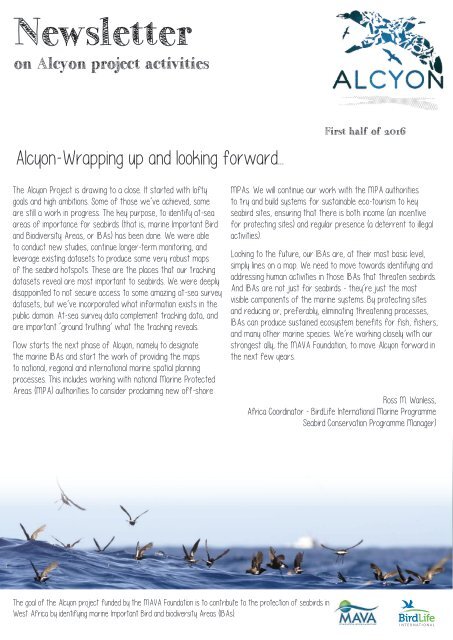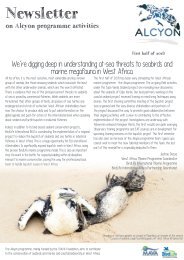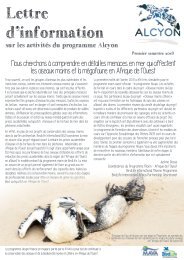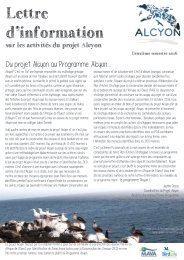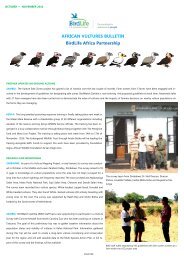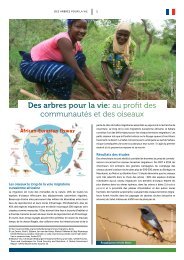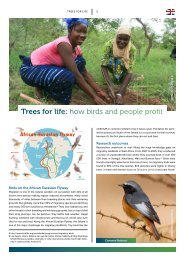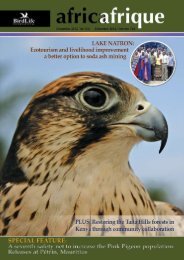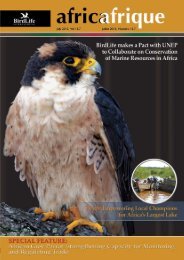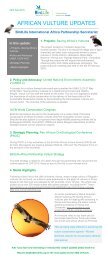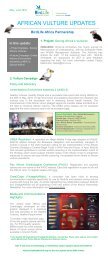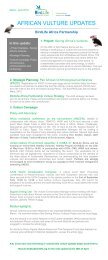ALcyon Newsletter-July 2016-EN
You also want an ePaper? Increase the reach of your titles
YUMPU automatically turns print PDFs into web optimized ePapers that Google loves.
<strong>Newsletter</strong><br />
on Alcyon project activities<br />
Alcyon-Wrapping up and looking forward...<br />
First half of <strong>2016</strong><br />
The Alcyon Project is drawing to a close. It started with lofty<br />
goals and high ambitions. Some of those we’ve achieved, some<br />
are still a work in progress. The key purpose, to identify at-sea<br />
areas of importance for seabirds (that is, marine Important Bird<br />
and Biodiversity Areas, or IBAs) has been done. We were able<br />
to conduct new studies, continue longer-term monitoring, and<br />
leverage existing datasets to produce some very robust maps<br />
of the seabird hotspots. These are the places that our tracking<br />
datasets reveal are most important to seabirds. We were deeply<br />
disappointed to not secure access to some amazing at-sea survey<br />
datasets, but we’ve incorporated what information exists in the<br />
public domain. At-sea survey data complement tracking data, and<br />
are important ‘ground truthing’ what the tracking reveals.<br />
Now starts the next phase of Alcyon, namely to designate<br />
the marine IBAs and start the work of providing the maps<br />
to national, regional and international marine spatial planning<br />
processes. This includes working with national Marine Protected<br />
Areas (MPA) authorities to consider proclaiming new off-shore<br />
MPAs. We will continue our work with the MPA authorities<br />
to try and build systems for sustainable eco-tourism to key<br />
seabird sites, ensuring that there is both income (an incentive<br />
for protecting sites) and regular presence (a deterrent to illegal<br />
activities).<br />
Looking to the future, our IBAs are, at their most basic level,<br />
simply lines on a map. We need to move towards identifying and<br />
addressing human activities in those IBAs that threaten seabirds.<br />
And IBAs are not just for seabirds - they’re just the most<br />
visible components of the marine systems. By protecting sites<br />
and reducing or, preferably, eliminating threatening processes,<br />
IBAs can produce sustained ecosystem benefits for fish, fishers,<br />
and many other marine species. We’re working closely with our<br />
strongest ally, the MAVA Foundation, to move Alcyon forward in<br />
the next few years.<br />
Ross M. Wanless,<br />
Africa Coordinator - BirdLife International Marine Programme<br />
Seabird Conservation Programme Manager)<br />
The goal of the Alcyon project funded by the MAVA Foundation is to contribute to the protection of seabirds in<br />
West Africa by identifying marine Important Bird and biodiversity Areas (IBAs).
In Senegal, our partners from DPN (National Parks<br />
of Senegal Department) have taken over avian fauna ecological<br />
monitoring of National Madeleine Islands Park (PNIM); namely, redbilled<br />
Tropicbird monitoring thanks to support from the BirdLife<br />
International Alcyon project. Indeed, PNIM managers, motivated by<br />
the research on red-billed Tropicbird ecology in PNIM as part of the<br />
collaboration with Cheikh Anta Diop University of Dakar (Senegal) to<br />
supervise a doctoral thesis, want to have greater understanding of<br />
avian fauna population trends in the park and to continue monitoring<br />
PNIM seabird colonies in order to sustain data collection by the<br />
student preparing her thesis. A number of years ago, PNIM lost<br />
almost all the data available on the different park species following<br />
an unfortunate event. In addition, the park team considered<br />
improving eco-tourism services provided by PNIM by establishing a<br />
permanent simple exhibition on its premises to increase the spinoffs<br />
of eco-tourism to ensure funding of long-term conservation of<br />
the park’s birds.<br />
A Technical Officer of PNIM visiting nests of Red-billed Tropicbird during a<br />
monthly monitoring (© Dossa)<br />
North-South twinning to study Audouin’s Gull migration between<br />
Europe and West Africa.<br />
One of the strengths of the Alcyon project has been to foster<br />
young West African scientist dynamism around seabird conservation.<br />
Among the students supervised by Alcyon, Ngoné Diop is preparing<br />
her doctoral thesis on animal biology at UCAD (Cheikh Anta Diop<br />
University of Dakar, Senegal) on the ecology of three (3) seabirds.<br />
The Audouin’s Gull, Larus audouinii, a species breeding in the<br />
Mediterranean coasts, is one of the species studied by Ngoné. In<br />
fact, to complete their vital cycle, Audouin’s Gulls rely heavily on<br />
West African coastal areas which are a shelter during their winter<br />
season when environmental conditions are bad in Spain and in other<br />
breeding sites.<br />
BirdLife International, through its Alcyon project, has promoted a<br />
North-South twinning between a team of seabird study specialists<br />
from the University of Barcelona and UCAD to co-supervise Ngoné’s<br />
thesis. As part of this twinning Ngoné Diop was attached to the<br />
Audouin’s Gull banding office in Spain (Doñana Biological Station<br />
natural process monitoring team - EBD). During observations made<br />
on the Audouin’s Gull in winter areas in Palmarin Natural Community<br />
Reserve in Senegal, the student has already managed to read the<br />
codes of 342 banded individuals coming from Spain.<br />
A Red-billed Tropicbird flying around the National Park of ‘Iles de la Madeleine’<br />
(PNIM), Senegal (© J. Dossa)<br />
Ngoné Diop, a UCAD PhD student, in the middle of counting and checking rings<br />
on Audouin’s Gulls at Palmarin (© J. Dossa)<br />
Audouin’s Gulls banded (right) from a colony of Spain reported on their wintering grounds in the Natural<br />
Community Reserve of Palmarin, Senegal(© N. Diop)
Following those ring readings, Ngoné collected information on the<br />
banding date and place of the individual in the breeding colony in<br />
Spain from the banding team website she accessed thanks to<br />
an individual code obtained as part of the twinning. The site also<br />
provides information about other places where each banded<br />
individual has already been observed.<br />
Ngoné says «Often, I happen to read a ring code of an individual<br />
just banded a few weeks earlier. For instance, two Audouin’s Gulls<br />
were banded on the 15th and the 19th of June 2015 respectively<br />
in the colony in Spain and I observed those birds with the same<br />
codes in Senegal; the first on 25th August and the second on 15th<br />
September in the same year. This allowed me to discover that<br />
certain juveniles migrate to Senegal just after their flight. These<br />
readings also give me an indication of the size of the wintering<br />
population as well as the annual survival of individuals in Palmarin.»<br />
In Cape Verde, our Biosfera I partners<br />
continued to implement Cape Verde shearwater conservation<br />
action plan activities. Indeed, the Biosfera I team deters the arrival<br />
of poachers and fishermen that disturb Cape Verde shearwater<br />
breeding on Raso Island thanks to its monitoring camp installed since<br />
the beginning of June, which will remain there until the end of<br />
November. The team has carried out full monitoring of shearwaters:<br />
banding, breeding success, diet, etc. Overall, 170 nests have already<br />
been monitored since the beginning of the season and the Biosfera<br />
I team has fitted 15 shearwaters with GPS; 14 of these devices<br />
have already been retrieved for data extraction and analysis to<br />
improve the information provided for the identification of marine<br />
IBAs in West Africa as part of the Alcyon project.<br />
Biosfera has also investigated prospecting new colonies of<br />
shearwater on other islands; namely in Santo Antao and the<br />
assessment of the size of infestation of Raso Island by fire<br />
ants with a view to establishing a control/eradication plan. The<br />
information collected by Biosfera on fire ants (Trichomyrmex<br />
destructor) is being analyzed by Biosecurity Queensland Control<br />
Centre (Australia), for the development of a pest management plan<br />
Monitoring of Cape Verde Shearwaters on Raso Island (© Biofera)<br />
Biosfera staff on the island of Santo Antao, on the way for prospecting new<br />
colonies of Cape Verde Shearwaters (© Biofera)<br />
for Raso Island. Also, the first results from the first prospecting<br />
of colonies in Santo Antao suggest that there is probably a colony<br />
of Cape Verde shearwaters on that island. The Alcyon project<br />
team provides support to the Biosfera team to track shearwaters<br />
captured at sea near that island using GPS-PTT devices based on<br />
well-developed identification methodology of new colonies to confirm<br />
these first investigations.<br />
Map of Raso Island showing inverstigation points (black dots) on the<br />
fire ants by the team of Biosfera (© Biosfera)
Off the coast of West Africa, Alcyon<br />
Project partners will meet with International Experts and the<br />
BirdLife International Marine Programme (BIMP) team during the<br />
14th Pan-African Ornithology Congress (PAOC) to assess the<br />
achievements of the project and discuss the sustainable outlook<br />
for the conservation of the sub-region’s seabirds. In fact, what<br />
makes the difference with previous PAOCs for the West African<br />
sub-region and Alcyon project partners is the diversity and content<br />
of presentations planned on seabird conservation in West Africa.<br />
Indeed, the Alcyon project funded by MAVA is the first regional<br />
project on seabird conservation in West Africa. Alcyon has<br />
highlighted a number of issues and challenges to be met in the field.<br />
The transfer of the project to BirdLife International has been a<br />
decisive turning-point for the sustainability of engaged conservation<br />
action. Alcyon has really provided leverage to establish a framework<br />
for the sustainable conservation of seabirds and other top<br />
predators in West Africa.<br />
Thus, the major conservation challenges now identified in the<br />
sub-region namely the issues linked to bad fishing practices; how<br />
can marine IBAs be used as effective tools to remedy most of<br />
the threats which are uncontrolled so far? How to incorporate<br />
seabird conservation in normal fishing practices? How to pool our<br />
efforts to implement a regional strategy and action plan for seabird<br />
conservation along the African East-Atlantic flyway?<br />
All these questions and others will be discussed during a symposium<br />
and a workshop organized as part of the Alcyon project next<br />
October.<br />
Cory’s Shearwater off Dakar (© R. Wanless)<br />
Sunset on the coast of Dakar, the welcoming city of the PAOC-14<br />
(© R. Wanless)<br />
Upcoming events<br />
News<br />
20 October <strong>2016</strong>: A symposium on seabirds: ‘Ecosystem approaches to fisheries for managing impacts on seabirds from forage<br />
fisheries, bycatch and the depletion of stocks’ (30 presentations already accepted and confirmed) during PAOC14 due to take place<br />
in Dakar, Senegal on 17-21 October <strong>2016</strong>.<br />
Also scheduled during the PAOC: Side events on marine IBAs and seabird conservation in West Africa<br />
21-22 October <strong>2016</strong>: A workshop for the wrapping up and outlook of the Alcyon project and launching the regional strategy &<br />
Action Plan for seabird conservation along the African East-Atlantic flyway in view of the sustainability of Alcyon achievements.<br />
Miguel Lecoq (miguel.lecoq@birdlife.org) has just joined the Alcyon project team as the marine Policy & Advocacy Officer. Miguel is<br />
based at the BirdLife International office in Dakar. We are counting on your cooperation to help him make progress in integrating<br />
marine IBAs in the different national, regional and international marine spatial planning.<br />
BirdLife is looking for a consultant for the Alcyon project final evaluation. Further details are available on BirdLife International<br />
website.<br />
For further information :<br />
Justine Dossa<br />
Alcyon Project Manager<br />
justine.dossa@birdlife.org<br />
www.birdlife.org


